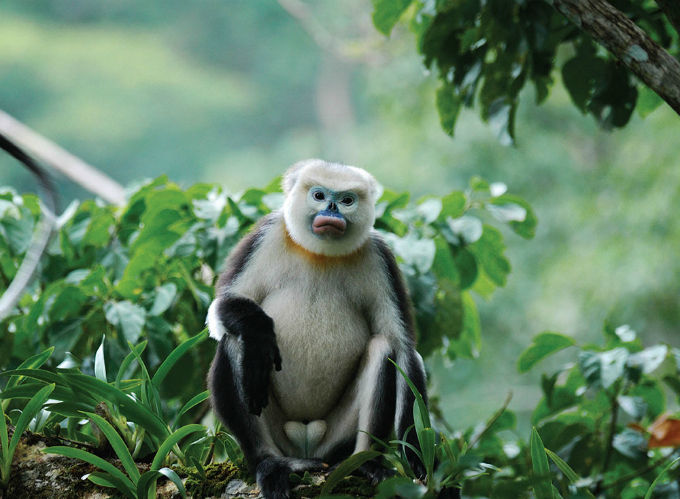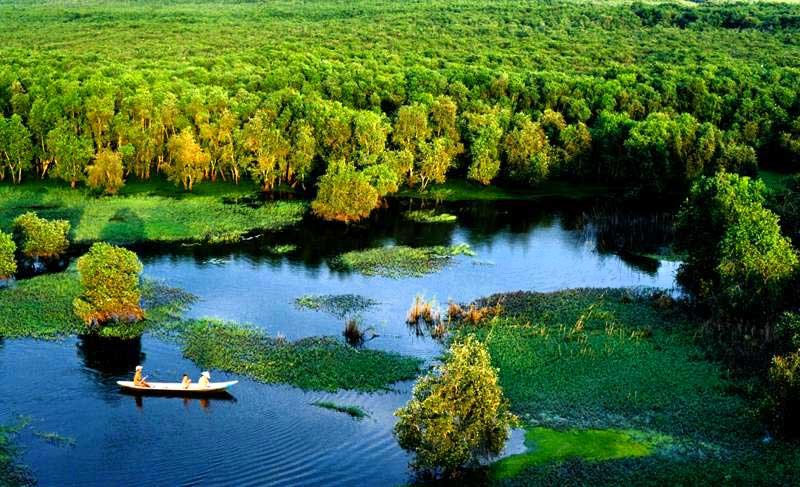The national parks of Việt Nam from north to south - Part 1
- edwardt314
- Oct 25, 2024
- 7 min read
Updated: Jan 16
Updated 10/26/2024
Việt Nam has 34 national parks, spreading fairly evenly in three regions: north, central, and south, with a total area of over 3,000,000 acres. Central Việt Nam has the most number of parks, 14, next is Northern Việt Nam, 11, and last is Southern Việt Nam, 9.
Source: Multiple authors, "Danh sách vườn quốc gia tại Việt Nam," vi.wikipedia.org. Last updated on September 20, 2024. https://vi.wikipedia.org/wiki/Danh_s%C3%A1ch_v%C6%B0%E1%BB%9Dn_qu%E1%BB%91c_gia_t%E1%BA%A1i_Vi%E1%BB%87t_Nam
Northern Việt Nam - Highlands
Bái Tử Long National Park
The park, in Quảng Ninh province, is in Bái Tử Long bay, 63 miles northeast of Hải Phòng (City). It consists of forty islands, with a total area of almost 60 square miles. According to the latest statistics, Bái Tử Long National Park has over 2,000 animal and fish species, that include endangered monkeys, deers, and sea turtles. The park is recognized as an ASEAN Heritage site in 2017.
Bái Tử Long National Park also has Minh Châu beach, a 2 mile stretch of smooth white sand.
Source: Unknown author. "Khám phá thiên nhiên ở Vườn quốc gia Bái Tử Long." Tạp chí Môi trường. May 6, 2019. https://tapchimoitruong.vn/thien-nhien-va-moi-truong-viet-nam-85/Kh%C3%A1m-ph%C3%A1-thi%C3%AAn-nhi%C3%AAn-%E1%BB%9F-V%C6%B0%E1%BB%9Dn-qu%E1%BB%91c-gia-B%C3%A1i-T%E1%BB%AD-Long-21395

Image source: Unknown photographer, "Bái Tử Long National Park," 2018. Accessed via https://baoquangninh.vn/den-voi-vuon-di-san-asean-vuon-quoc-gia-bai-tu-long-2408552.html Altered from source photo.

Image source: Unknown photographer, "Đảo Minh Châu," 2024. Accessed via https://dulich.quangninh.gov.vn/Trang/ChiTietTinTuc.aspx?nid=4379 Altered from source photo.
Ba Bể National Park
The park, 155 miles northwest of Hà Nội, is in Bắc Kạn province, with a size of about 25,600 acres. Ba Bể National Park was recognized as an ASEAN Heritage site in 2003. It is here that the Hòa Bình culture (pre-Đông Sơn), which existed 10,000 years ago, was discovered. Lake Ba Bể, at the center of the park, is 500 feet above sea level.
The park has over 900 plant species, that include precious woods and rare medicinal herbs, and over 400 animal and fish species, that include unusual primates, civets, and reptiles.
Source: Unknown author. "Vườn Quốc Gia Ba Bể." vuonquocgiababe.com. Date unknown. https://vuonquocgiababe.com/gioi-thieu/gioi-thieu-chung.html

Image source: Unknown photographer, "Vườn quốc gia Ba Bể," Year unknown. Accessed via https://vuonquocgiababe.com/en/ Altered from source photo.

Image source: Unknown photographer. "Vườn quốc gia Ba Bể," Year unknown. Accessed via https://vuonquocgiababe.com/en/news/kham-pha-cac-diem-den-thu-hut-cua-ba-be.html Altered from source photo.
Phia Oắc-Phia Đén National Park
The park, 150 miles north of Hà Nội, is in Cao Bằng province, with an area of more than 25,600 acres. Phia Oắc-Phia Đén is mountainous, with the highest peak over 6,500 feet. The park has almost 2,000 rare animal and plant species, that include black bear and musk deer, and the highest concentration of bat species in Việt Nam, at nearly 120. Sixty six butterfly species are also found here.
Source: Unknown author. "Phia Oac - Phia Den national park established in Cao Bang." Báo Nhân Dân. May 14, 2018. https://en.nhandan.vn/phia-oac-phia-den-national-park-established-in-cao-bang-post60678.html
Vuong Tan Tu. "Recent remarkable records reveal that Phia Oac-Phia Den Nature Reserve is a priority area for bat conservation in Northern Vietnam." Journal of Asia-Pacific Biodiversity. September 2016. https://www.sciencedirect.com/science/article/pii/S2287884X16300358
Multiple author, "Vườn quốc gia Phia Oắc - Phia Đén," vi.wikipedia.org. Last updated on January 5, 2023. https://vi.wikipedia.org/wiki/V%C6%B0%E1%BB%9Dn_qu%E1%BB%91c_gia_Phia_O%E1%BA%AFc_%E2%80%93_Phia_%C4%90%C3%A9n

Image source: Unknown photographer, "Vườn quốc gia Phja Oắc - Phja Đén," 2019. Accessed via https://baocaobang.vn/-31402.html Altered from source photo.

Image source: Unknown photographer, "Hùng Vĩ Phja Oắc," 2023. Accessed via https://baocaobang.vn/-1680.html Altered from source photo.
Tam Đảo National Park
The park, only forty miles northwest of Hà Nội, borders three provinces: Thái Nguyên, Tuyên Quang, and Vĩnh Phúc. It is one of the larger national parks in Việt Nam, with over 89,600 acres in size. Tam Đảo National Park is known for its bamboo forest, that extends over 2,000 acres. The park has over 2,000 plant and animal species, that includes endemic birds, insects and amphibians to Việt Nam.
Source: Unknown author. "Tam Dao National Park." vietnam.com. Date unknown. https://www.vietnam.com/en/northern-vietnam/other-places-of-interest/tam-dao-national-park.html
Multiple authors. "Tam Đảo National Park." en.wikipedia.org. Last updated on August 13, 2024. https://en.wikipedia.org/wiki/Tam_%C4%90%E1%BA%A3o_National_Park

Image source: Unknown photographer. "Tam Đảo National Park," 2017. Accessed via https://endemicvietnamtourism.gov.vn/en/post/12039 Altered from source photo.

Image source: Unknown photographer, "Thác Bạc," 2023. Accessed via https://ven.congthuong.vn/tam-dao-a-world-leading-destination-46779.html Altered from source photo.
Xuân Sơn National Park
The park, 85 miles west of Hà Nội, is in Phú Thọ province, with an area of about 38,400 acres. Eighty four percent of Xuân Sơn National Park is forestland. It has over 1,000 animal and plant species, that include the largest number of goat-antelopes in Việt Nam.
Source: Unknown author. "Xuan Son National Park develops community tourism." Viet Nam National Authority of Tourism. May 17, 2019. https://vietnamtourism.gov.vn/en/post/13759

Image source: Unknown photographer, "Xuân Sơn National Park," Year unknown. Accessed via https://vuonquocgiaxuanson.com.vn/gioi-thieu Altered from source photo.
Hoàng Liên National Park
The park, an ASEAN Heritage site, is in Lào Cai province, with the total area of 169,600 acres. Hoàng Liên National Park, 150 miles northwest of Hà Nội, has Fansipan Peak, the highest one in the Indochinese Peninsula. The elevation here ranges between 3,300 and 10,000 feet.
The park has 199 butterfly species and almost 350 bird's, that include 49 endangered ones. One third of all amphibian species in Việt Nam can be found within here.
Source: Multiple authors, "Hoàng Liên National Park," en.wikipedia.org. Last updated on October 22, 2024. https://en.wikipedia.org/wiki/Ho%C3%A0ng_Li%C3%AAn_National_Park

Image source: Unknown photographer, "Fansipan Peak," 2017. Accessed via https://www.hanoijourney.com/fansipan-mountain/ Altered from source photo.
Du Già National Park
The park, the northernmost one, and 225 miles from Hà Nội, is in Hà Giang province. It is located on the Đồng Văn Karst plateau, covering 38,400 acres. Du Già National Park has 35 critically endangered species, that include the Tonkin snub-nosed monkey.
Source: Multiple authors. "Vườn quốc gia Du Già." vi.wikipedia.org. Last updated on February 4, 2022. https://vi.wikipedia.org/wiki/V%C6%B0%E1%BB%9Dn_qu%E1%BB%91c_gia_Du_Gi%C3%A0
Unknown author. "Du Gia National Park in Ha to be established." Viet Nam National Authority of Tourism. August 20, 2015. https://vietnamtourism.gov.vn/en/post/9353

Image source: Unknown photographer, "Du Già National Park," 2015. Accessed via https://vietnamtourism.gov.vn/en/post/9353 Altered from source photo.

Image source: Unknown photographer, "Tonkin snub-nosed monkey," 2016. Accessed via https://e.vnexpress.net/news/news/meet-vietnam-s-endangered-primates-3513639.html Unaltered from source photo.
Northern Việt Nam - Lowlands
Cát Bà National Park
The park, less than 30 miles east of Hải Phòng (City), is located on the Cát Bà Archipelago, which consists of 366 islands in Lan Hạ Bay. Cát Bà National Park, a UNESCO Biosphere Reserve, has a total area of 65 square miles: 42 square miles of islands and 23 square miles of water. It has attracted millions of visitors since its inception in 1986.

Image source: Unknown photographer, "Cát Bà National Park," Year unknown. Accessed via https://catbanationalpark.vn/cat-ba-photos-7 Altered from source photo.
Cát Bà National Park is rich in animal and plant species, over 3,000. It also has a number of endangered species, that include the Cát Bà Langur.
Source: Unknown author. "Cat Ba National Park." catbanationalpark.vn. Date unknown. https://catbanationalpark.vn/

Image source: Unknown photographer, "Cát Bà Langur," Year unknown. Accessed via https://catbanationalpark.vn/cat-ba-photos-6 Altered from source photo.
Xuân Thủy National Park
The park, 93 miles southeast of Hà Nội, and at the mouth of the Red River, is in Nam Định province. Xuân Thủy National Park is a beautiful mangrove forest, with the size of about 18,000 acres. It provides a wetland haven for 219 bird species. and also other migratory ones. In addition, the park has 150 plant species that thrive in this habitat.
Source: Unknown author. "Vườn Quốc Gia Xuân Thủy." vuonquocgiaxuanthuy.org.vn. September 8, 2015. https://www.vuonquocgiaxuanthuy.org.vn/?act=newscat&cat_id=1&id=388

Image source: Unknown photographer, "Mangroves and migratory birds," Date unknown. Accessed via https://www.vuonquocgiaxuanthuy.org.vn/?lang=en Altered from source photo.
Ba Vì National Park
The park nestles between Hà Nội and Hòa Bình province, about 30 miles west of the capital center. Ba Vì National Park is situated on the mountain range of the same name, with a total area of 27,500 acres. It is a subtropical forest, rich in flora and fauna species, over 1,000.
Source: Multiple authors. "Ba Vì National Park." en.wikipedia.org. Last updated on October 11, https://en.wikipedia.org/wiki/Ba_V%C3%AC_National_Park
Unknown author. "Vườn Quốc Gia Ba Vì." vuonquocgiabavi.com.vn. Date unknown. https://vuonquocgiabavi.com.vn/khoa-hoc-va-htqt/he-thuc-vat/

Image source: Phạm Thắng, "Ba Vi National Park," 1972. Accessed via https://en.wikipedia.org/wiki/Ba_V%C3%AC_National_Park Altered from source photo.
Cúc Phương National Park
The park, 75 miles southwest of Hà Nội, nestles among three provinces: Ninh Bình, Hòa Bình, and Thanh Hóa. Cúc Phương National Park, established in 1962, is the first and oldest national park in Việt Nam. The park, with a size of 50,700 acres of dense forest, offers a habitat for some of Asia's rarest animal and plant species, that include Clouded Leopard, Delacour's Langur, and Owston' Palm Civet. A fossilized sea reptile, dated between 200 and 300 million years ago, was also found here, along with the remains of the prehistoric people, who lived some 7,500 years ago.
Cúc Phương National Park is home to the Mường ethnic group, one of the fifty three minority groups in Việt Nam. One can see their traditional stilt houses, water wheels, and bamboo rafts, in the villages on the periphery of the park.
Source: Unknown author. "Welcome to Cúc Phương National Park." cucphuongtourism.com.vn. Date unknown. http://cucphuongtourism.com.vn/

Image source: Unknown photographer. "Cúc Phương National Park," Year unknown. Accessed via http://cucphuongtourism.com.vn/ Altered from source photo.
Even though Việt Nam has a later start, not until 1962, I am impressed that it now has 34 national parks, as of 2024. My next blog in this series will be about the national parks in coastal Central Việt Nam. Please leave a comment if you enjoy reading this.



This is a test. No email is required.